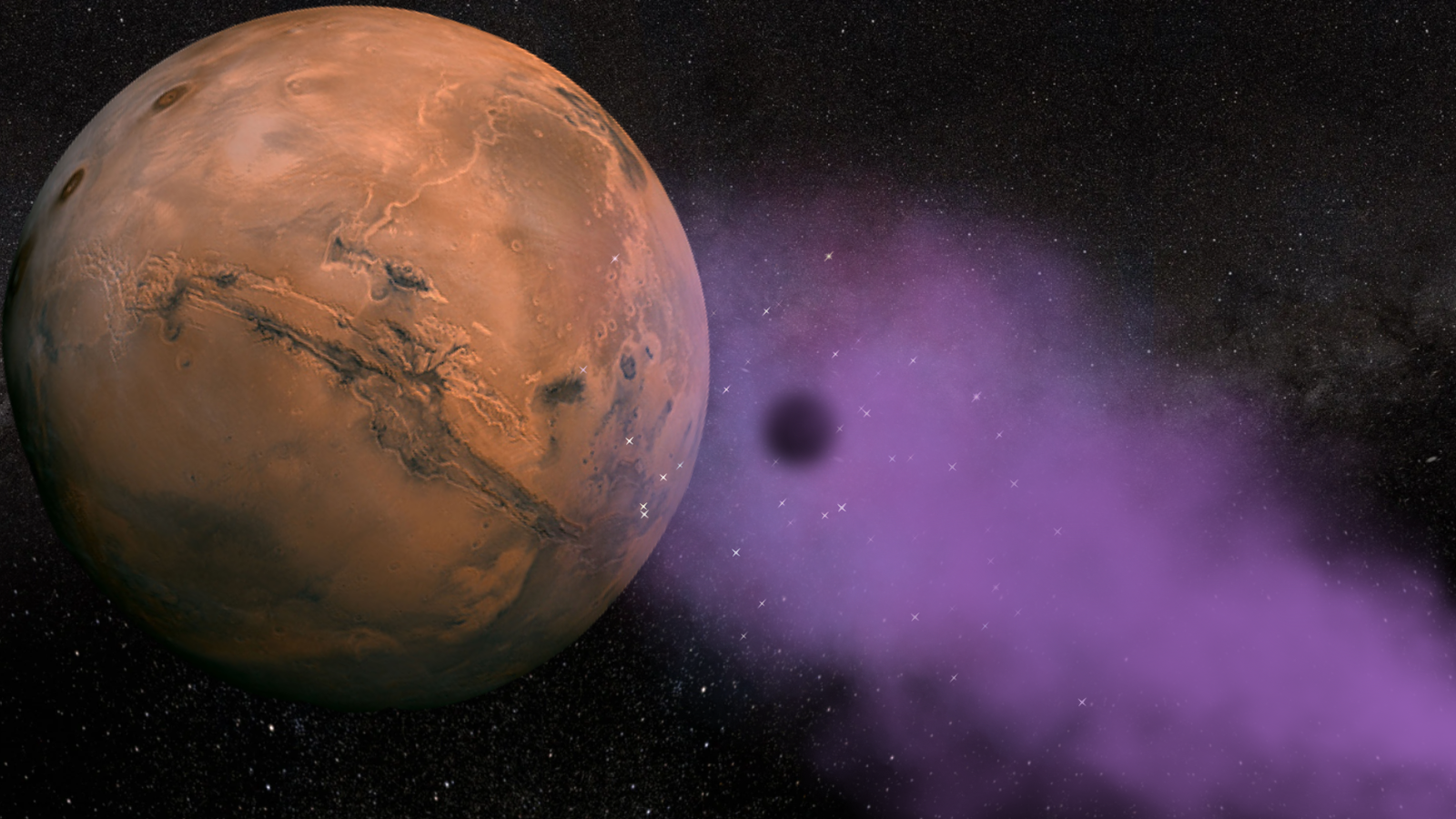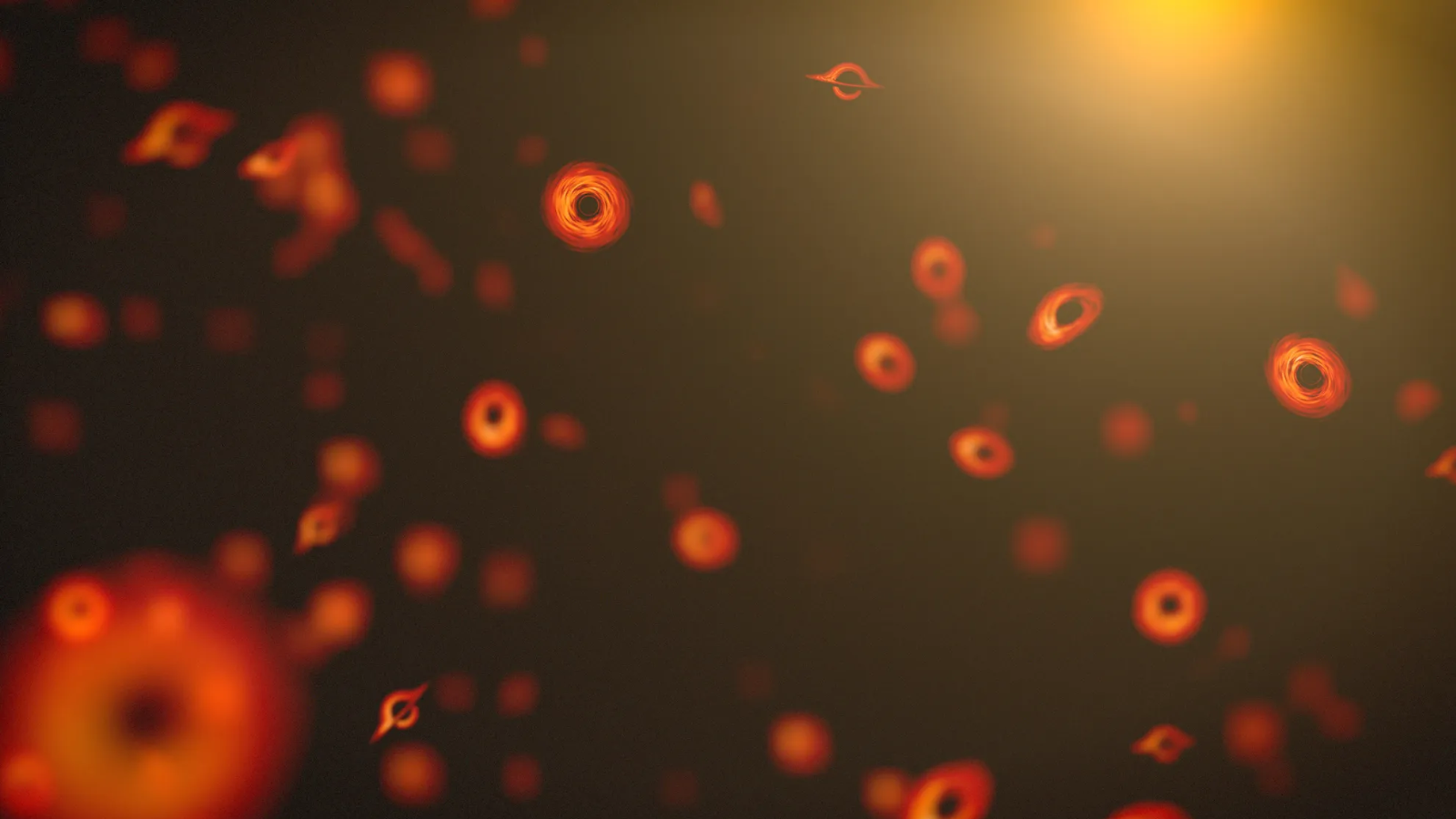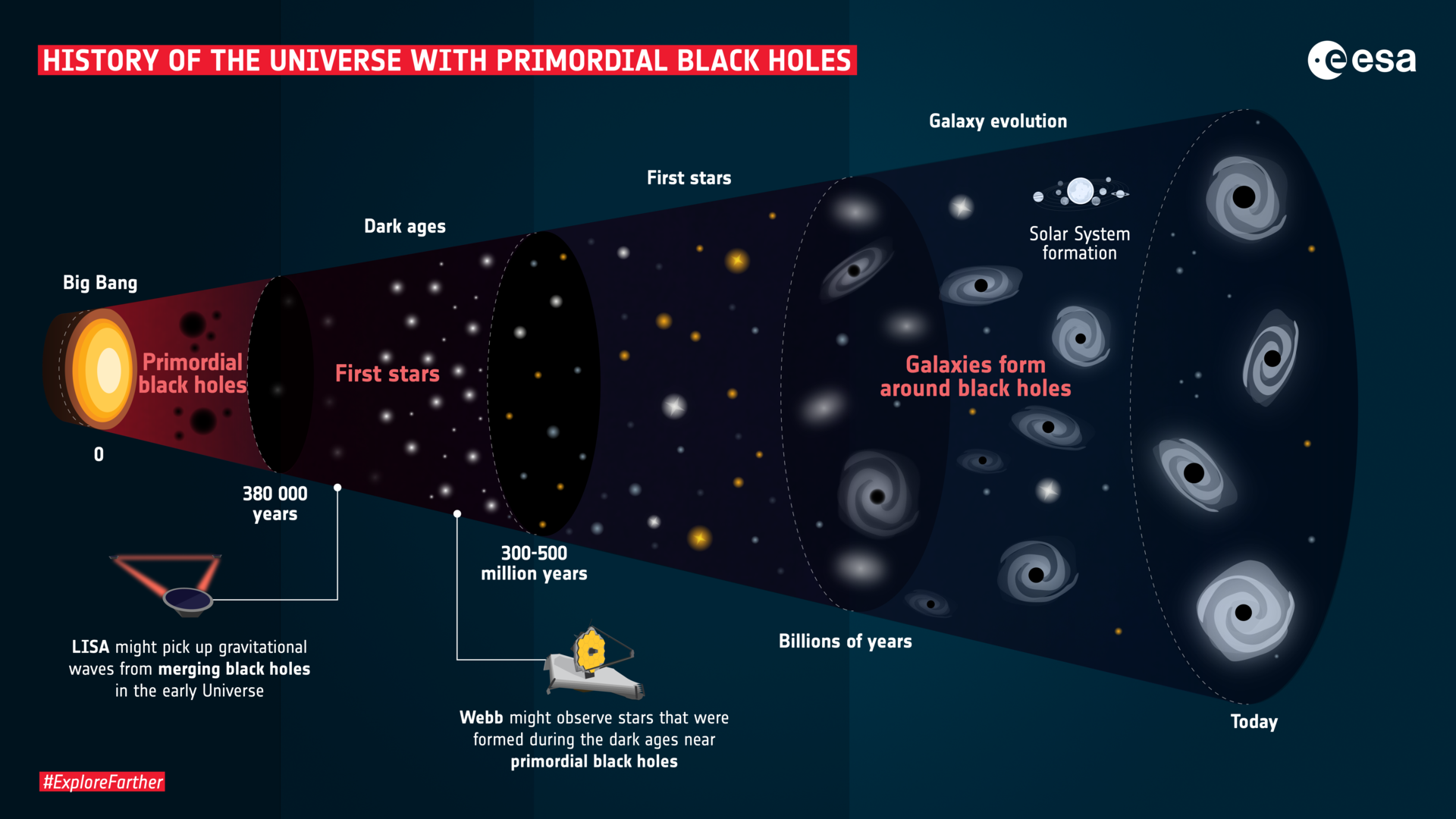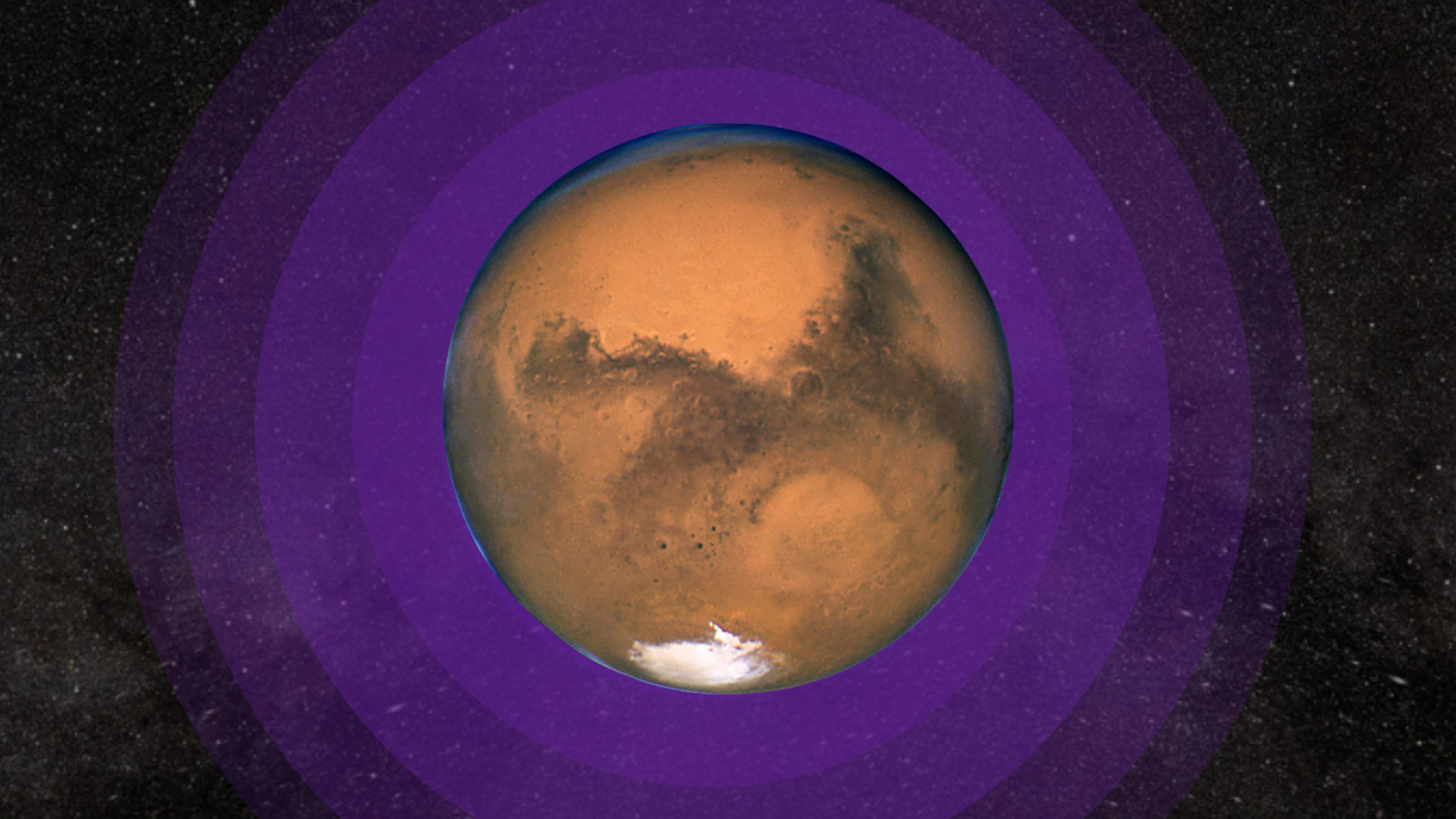Black hole 'bullets' fired at Mars could reveal more about dark matter
"Primordial black holes do not live in the solar system. Rather, they’re streaming through the universe, doing their own thing. And the probability is, they’re going through the inner solar system at some angle once every ten years or so."

Primordial black hole "bullets," traveling at speeds greater than 7,000 times the speed of sound, may be punching through our solar system — and they could be causing a tiny wobble in Mars' motion. Ultimately, measuring this wobble could help crack one of the most pressing mysteries in science: the true nature of dark matter.
Scientists believe primordial black holes were created at the beginning of time. These objects are very different from so-called "astrophysical black holes" like Sagittarius A* (Sgr A*) that sits at the heart of the Milky Way. For instance, while Sgr A* has a mass of around 4.3 million times that of the sun, primordial black holes are hypothesized to be about as massive as an asteroid or small moon, and be vastly smaller than atoms.
Some scientists also theorize that conglomerations of these tiny black holes could account for dark matter, the most mysterious "stuff" in the universe. Others, however, argue that primordial black holes would have evaporated long ago via the emission of so-called "Hawking radiation," meaning they can't be dark matter suspects in the modern universe. Now, a team of physicists proposes a way of settling the debate: with detailed observations of Mars.
The scientists suggest that if primordial black holes do make up dark matter, they should race through the solar system at least once a decade. This flyby could cause a "wobble" in Mars' orbit that is detectable using current technology, thanks to our precise documentation of the Red Planet's orbit.
Related: Dark Energy Camera's new galactic portrait delves into dark-matter central
"Given decades of precision telemetry, scientists know the distance between Earth and Mars to an accuracy of about 10 centimeters [3.9 inches]," team member David Kaiser, Germeshausen Professor of the History of Science at the Massachusetts Institute of Technology, said in a statement."We're taking advantage of this highly instrumented region of space to try and look for a small effect.
"If we see it, that would count as a real reason to keep pursuing this delightful idea that all of dark matter consists of black holes that were spawned in less than a second after the Big Bang and have been streaming around the universe for 14 billion years."
Get the Space.com Newsletter
Breaking space news, the latest updates on rocket launches, skywatching events and more!
Big problem; tiny solution
To understand why dark matter is such a huge problem for physicists, consider that it outweighs "everyday" particles by a factor of five to one. That means every star, planet, moon, asteroid, gas cloud, rocket, satellite and spacecraft you read about on Space.com or observe from your backyard telescope accounts for under 20% of the universe's total mass.
Scientists know dark matter can't be made of atoms, which are comprised of protons, neutrons and electrons. That is because those particles interact with light, or, more accurately, electromagnetic radiation. Dark matter doesn't interact with light — or if it does, this interaction happens so weakly that it's undetectable. That makes dark matter effectively invisible to us. Rather, scientists can only infer the existence of dark matter through its interaction with gravity and by how this interaction affects light and ordinary matter — like the 642 million trillion metric tons of matter that make up Mars!

Thus far, the search for dark matter candidates has focused on hitherto undiscovered particles. However, as these searches grow more sophisticated (but still turn up empty-handed), scientists are increasingly turning to an idea first posited in the 1970s: Dark matter may not be a particle at all, but instead tiny black holes left over from the Big Bang.
These primordial black holes wouldn't form from the collapse of massive stars like stellar-mass black holes do, or form a merger chain of increasingly more massive black hole pairs like supermassive black holes do. Instead, primordial black holes, if they exist, would have formed from dense pockets of gas in the early universe, with the rapid expansion of the cosmos distributing them across space.
Considering the gravitational impact of such a primordial black hole started with an idle musing.
"I think someone asked me what would happen if a primordial black hole passed through a human body," Team leader Tung Tran, a graduate student at Stanford University, said in a statement.
From this question, Tran calculated that if a black hole with the mass of an asteroid passed within around 3.2 feet (1 meter) of a person, the force it asserted would push that person 20 feet (6 meters) in a single second. So, why does this thankfully never happen? Well, Tran also found that the odds of a primordial black hole passing anywhere near a person on Earth are infinitesimally small.
Interest piqued, Tran reasoned that to increase the odds of such an interaction happening, you'd need an object of much more size and width than a person. But, the more massive the body, the smaller the effect would be.
Primordial black hole meets Mars
Tran first turned to our Earth/moon system.
"We extrapolated to see what would happen if a black hole flew by Earth and caused the moon to wobble by a little bit," Tran said. "The numbers we got were not very clear. There are many other dynamics in the solar system that could act as some sort of friction to cause the wobble to dampen out."
To help clarify this developing picture, the researchers created a simple simulation of the solar system that factored in gravitational interactions between the planets and the largest moons in our cosmic backyard.
"State-of-the-art simulations of the solar system include more than a million objects, each of which has a tiny residual effect," team member and MIT Pappalardo Fellow Benjamin Lehmann said in a statement. "But even modeling two dozen objects in a careful simulation, we could see there was a real effect that we could dig into."
The team then estimated how often a primordial black hole would theoretically pass through the solar system, given the amount of dark matter estimated to exist in the region of space around the sun.
"Primordial black holes do not live in the solar system. Rather, they’re streaming through the universe, doing their own thing," Sarah Geller, team member and postdoc at the University of California at Santa Cruz, said in the statement "And the probability is, they're going through the inner solar system at some angle once every 10 years or so."

With the rate of primordial black hole passages calculated and considering the asteroid-range mass of these dark matter candidates, the team then reasoned that these tiny black holes would race through the solar system at a staggering 5.4 million miles per hour, or about 7,000 times as fast as the speed of sound.
Focusing on "close encounters" between these racing black holes and solar system bodies, the team discovered that Mars actually presented a better target than Earth or the moon — at least one that paints a better picture of the interactions the team is interested in.
The team found that if a primordial black hole passed within around a few hundred million miles of Mars, it would cause a deviation in the Red Planet's orbit. To put into perspective just how small that is, Mars is over 140 million miles from Earth, a distance that's a staggering 225 trillion times greater than the proposed effect.
Despite this, the team thinks that the instruments currently monitoring Mars would indeed be able to spot such a small deviation.

However, even if this deviation was detected over the next few decades, scientists would still have to confirm that it was indeed caused by a primordial black hole and not a passing asteroid with the same mass.
"We need as much clarity as we can of the expected backgrounds, such as the typical speeds and distributions of boring space rocks, versus these primordial black holes," Kaiser said. "Luckily for us, astronomers have been tracking ordinary space rocks for decades as they have flown through our solar system, so we could calculate typical properties of their trajectories and begin to compare them with the very different types of paths and speeds that primordial black holes should follow."
"It’s a very neat test they've proposed, and it could tell us if the closest black hole is closer than we realize," Matt Caplan, associate professor of physics at Illinois State University, who was not involved in the study, said in the statement. "I should emphasize there’s a little bit of luck involved, too. Whether or not a search finds a loud and clear signal depends on the exact path a wandering black hole takes through the solar system.
"Now that they've checked this idea with simulations, they have to do the hard part — checking the real data."
The team's research was published on Tuesday (Sept. 17) in the journal Physical Review D.
Join our Space Forums to keep talking space on the latest missions, night sky and more! And if you have a news tip, correction or comment, let us know at: community@space.com.

Robert Lea is a science journalist in the U.K. whose articles have been published in Physics World, New Scientist, Astronomy Magazine, All About Space, Newsweek and ZME Science. He also writes about science communication for Elsevier and the European Journal of Physics. Rob holds a bachelor of science degree in physics and astronomy from the U.K.’s Open University. Follow him on Twitter @sciencef1rst.
-
Torbjorn Larsson ReplyPrimordial black holes are too scarce to explain dark matterA decades-long survey of a nearby galaxy has detected signals consistent with ancient black holes that could explain dark matter — but the objects would have to be at least ten times more abundant to support the theory.
Specifically, they considered a range of PBHs with masses ranging from 1.8 \00d7 10–4 times to 6.3 times that of the Sun. They found that these black holes comprise no more than 1% of the inferred abundance of dark matter. Widening the mass range to between 1.3 \00d7 10–5 and 860 solar masses upped the contribution of PBHs to no more than 10%.
https://www.nature.com/articles/d41586-024-02526-y -
Fruitmaniac Reply
Aren't PBHs the best explanation for supermassive black holes, which couldn't have formed as stellar black holes?Torbjorn Larsson said:https://www.nature.com/articles/d41586-024-02526-y -
Unclear Engineer This article talks about measuring "wobbles" in Mars' orbit due to a black hole the mass of an asteroid passing within "a few hundred million miles of Mars" about once every 10 years. I really question the ability to determine that the effect was not from one of the many real asteroids that are within that distance from Mars in the asteroid belt and outside that belt, too, plus other visitors like comets.Reply
And, why are these primordial black holes going to be traveling at 5.4 million miles per hour? That is more than 4 times the escape velocity from our galaxy, starting from Earth.
Finding one unexplained wobble about every 10 years, and being able to imagine any black hole mass passing at any distance from Mars to "explain" it seems like it would have extremely low credibility for a theory. -
Questioner I, in my infinite wisdom hypothesize BHs collapse into the past.Reply
In the early universe there was little or no past to collapse into.
Therefore there could only be trivial BHs if any at that early stage of the universe.









